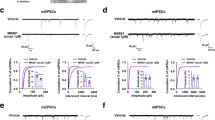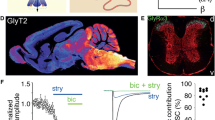Abstract
We have previously reported that enhanced glycine release is produced by epidural spinal cord stimulation, a clinical method for treating neuropathic pain. Our current hypothesis is that glycine administered intrathecally reduces neuropathic pain as measured by the Randall-Selitto method. Neuropathic rats created by unilateral partial ligation of the sciatic nerve were treated with intrathecal infusion of glycine, strychnine, MK-801, or 5,7-DKA at 0.1 μmol, or artificial CSF for 2 hours at a rate of 10 μl/min. Force required to produce the pain response was significantly increased after glycine administration and reduced using strychnine, a specific glycine receptor (Gly 1) antagonist. Strychnine blocked the response to glycine when infused together. Administration of the non-specific NMDA receptor MK-801 antagonist and 5,7-DKA, a specific glycine-NMDA receptor (Gly 2) antagonist, however, failed to block the response to glycine. Our results provide evidence for the use of glycine and related compounds to treat neuropathic pain.
Similar content being viewed by others
References
Simpson, R. K. Jr., Robertson, C. S., and Goodman, J. C. 1992. Segmental amino acid neurotransmitter recovery during posterior epidural stimulation after spinal cord injury. J. Am. Paraplegia Soc. 16:34–41.
Simpson, R. K. Jr., Robertson, C. S., and Goodman, J. C. 1989. Alterations in the corticomotor evoked potential following spinal cord ischemia. J. Neurosci. Meth. 28:171–178.
Simpson, R. K. Jr., Robertson, C. S., and Goodman, J. C. 1991. Release of segmental amino acid neurotransmitters in response to peripheral afferent and motor cortex stimulation: A pilot study. Life Sci. 49:113–118.
Simpson, R. K. Jr., Robertson, C. S., and Goodman, J. C. 1991. Segmental release of amino acid neurotransmitters from transcranial stimulation. Neurochem. Res. 16:89–94.
North, R. B., Ewend, M. G., Lawton, M. T., Kidd, D. H., and Piantadosi, S. 1991. Failed back surgery syndrome: 5-year followup after spinal cord stimulator implantation. Neurosurgery, 28:692–699.
Hosobuchi, Y. 1978. Subcortical electrical stimulation for control of intractable pain in humans. J. Neurosurg. 64:543–553.
Racz, G. B., Lewis, R., Heavner, J. E., and Scott, J. 1990. Peripheral nerve stimulator implant for treatment of causalgia. Pages 225–239in Stanton-Hicks, M., (ed), Pain and the sympathetic nervous system. Kluwer Academic Publishers, Boston.
Simpson, R. K. Jr., Halter, J. A., and Auzzene, D. G. 1992. Tissue adhesive to secure epidural spinal cord stimulating electrodes: Technical note. Surg. Neurol. 38:391–393.
Simpson, R. K. Jr., Robertson, C. S., and Goodman, J. C. 1993. Glycine: A potential mediator of electrically induced pain modification. Biomed. Lett. 48:193–207.
Bennett, G. J., and Xie, Y. K. 1988. A peripheral mononeuropathy in rat that produces disorders of pain sensation like those seen in man. Pain 33:87–107.
Mitchell, S. W., Morehouse, G. R., and Keen, W. W. 1864. Gunshot wounds and injuries of nerves. Philadelphia, JB Lippincott.
Melzack, R., and Wall, P. D. 1965. Pain Mechanisms: A new theory. Science 150:971–979.
Zieglgansberger, W. and Herz, A. 1971. Changes of cutaneous receptive fields of spino-cervical-tract neurones and other dorsal horn neurones by microelectrophoretically administered amino acids. Brain Res 13:111–126.
Basbaum, A. I. 1988. Distribution of glycine receptor immunoreactivity in the spinal cord of the rat: Cytochemical evidence for a differential glycinergic control of lamina I and V nociceptive neurons. J. Comp. Neurol. 278:330–336.
Mitchell, K., Spike, R. C., and Todd, A. J. 1993. An immunocytochemical study of glycine receptor and GABA in lamine 1-III of rat spinal dorsal horn. J. Neurosci. 13:2371–2381.
Ren, K., Hylden, L. K., Williams, G. M., Ruda, M. A., and Dubner, R. The effects of a non-competative NMDA receptor antagonist, MK-801, on behavior hyperalgesia and dorsal horn neuronal activity in rats with unilateral inflammation. Pain 50:331–344.
Padjen, A. L., Mitsoglou, G. M. and Hassessian, H. 1989. Further evidence in support of taurine as a mediator of synaptic transmission in the frog spinal cord. Brain. Res. 488:288–296.
Aprison, M. H. 1990. The discovery of the neurotransmitter role of glycine. Pages 1–23in Ottersen, O. P., and Storm-Mathisen, J., (eds), Glycine Neurotransmission. John Wiley & Sons Ltd., New York.
Curtis, D. R., Duggan, A. W., and Johnston, G. A. R. 1971. The specificity of strychnine as a glycine antagonist in the mammalian spinal cord. Exp. Brain. Res. 12:547–565.
Berger, S. J., Carter, J. G., and Lowry, O. H. 1977. The distribution of glycine, GABA, glutamate, and aspartate in rabbit spinal cord, cerebellum and hippocampus. J. Neurochem. 28:149–158.
Graham, L. T., Shank, R. P., Werman, R., and Aprison, M. H. 1967. Distribution of some synaptic transmitter suspects in cat spinal cord: glutamic acid, aspartic acid, g-aminobutyric acid, glycine, and glutamine. J. Neurochem. 14:465–472.
Rudomin, P., Solodkin, M., and Jimenz, I. 1986. PAD and PAH response patterns of group Ia and Ib fibers to cutaneous and descending inputs to the cat spinal cord. J. Neurophysiol. 56:987–1006.
Rudomin, P., Solodkin, M., and Jimenz, I. 1987. Synaptic potentials of primary efferent fibers and motorneurons evoked by single intermediate nucleus interneurons in the cat spinal cord. J. Neurophysiol. 57:1288–1313.
Haefely, W. 1990. The Gaba-benzodiazepine interaction fifteen years later. Neurochem. Res. 15:169–174.
Todd, A. J. 1989. Cells in laminae III and IV of rat spinal dorsal horn receive monosynaptic primary afferent input in lamina II. J. Comp. Neurol. 289:676–686.
Kajander, K. C., Wakisaka, S., and Bennett, G. J. 1992. Spontaneous discharge originates in the dorsal root ganglion at the onset of a painful peripheral neuropathy in the rat. Neurosci. Letters. 138:225–228.
Sotgui, M. L. 1993. Descending influence on dorsal horn neuronal hyperactivity in a rat model of neuropathic pain. NeuroReport 4:21–24.
Larson, A. A. 1989. Intrathecal GABA, glycine, taurine or betaalanine elicits dyskinetic movements in mice. Pharmacol. Biochem. Behav. 32:505–509.
Nasstrom, J., Karlsson, U., and Post, C. 1992. Antinociceptive actions of different classes of excitatory amino acid receptor antagonist in mice. Euro. J. Pharmacol, 212:21–29.
Haley, J. E., Sullivan, A. F., and Dickenson, A. H. 1990. Evidence for spinal N-methyl-D-aspartate receptor involvement in prolonged chemical nociception in the rat. Brain. Res. 518:218–226.
Mao, J., Price, D. D. and Mayer, D. J. 1992. Intrathecal MK-801 and local nerve anesthesia synergistically reduce nociceptive behaviors in rats with experimental peripheral mononeuropathy. Brain Res. 576:254–262.
Rao, T. S., Cler, J. A., Emmett, M. R., Mick, S. J., Iyengar, S., and Wood P. L. 1990. Glycine, glycinamide and D-serine act as positive modulators of signal transduction at the N-methyl-D-as-partate (NMDA) receptor in vivo: differential effects on mouse cerebellar glycic guanosine monophosphate levels. Neuropharmacology 29:1075–1080.
Corbett, R., and Cunn, R. W. 1993. Effects of 5,7 dichlorokynurenic acid on conflict social interaction and plus maze behaviors. J. Neuropharmacol. 32:461–466.
Kloog, Y., Lamdani-Itkin, H., Sokolovsky, M. 1990. The glycine site of the N-methyl-D-aspartate receptor channel: Differences between the binding of HA-966 and of 7-chlorokynurenic acid. J. Neurochem. 54:1576–1583.
Thomson, A. M. 1990. Glycine is a coagonist at the NMDA receptor/channel complex. Prog. Neurobiol. 35:53–74.
Yaksh, T. L. 1989. Behavioral and autonomic correlates of the tactile evoked allodynia produced by spinal glycine inhibition: Effects of modulatory receptor systems and excitatory amino acid antagonists. Pain 37:111–123.
Yamamoto, T., and Yaksh, T. L. 1993. Effects of intrathecal strychnine and bicuculline on nerve compression-induced thermal hyperalgesia and selective antagonism by MK-801. Pain 54:79–84.
Yamamoto, T., and Yaksh, T. L. 1992. Spinal pharmacology of thermal hyperesthesia induced by constriction injury of sciatic nerve. Excitatory amino acid antagonists. Pain 49:121–128.
Simpson, R. K. Jr., Robertson, C. S., Goodman, J. C., and Halter, J. A. 1991. Recovery of amino acid neurotransmitters from the spinal cord during posterior epidural stimulation: A preliminary report. J. Am. Paraplegia Soc. 14:4–9.
Author information
Authors and Affiliations
Rights and permissions
About this article
Cite this article
Simpson, R.K., Gondo, M., Robertson, C.S. et al. Reduction in the mechanonociceptive response by intrathecal administration of glycine and related compounds. Neurochem Res 21, 1221–1226 (1996). https://doi.org/10.1007/BF02532399
Accepted:
Issue Date:
DOI: https://doi.org/10.1007/BF02532399




